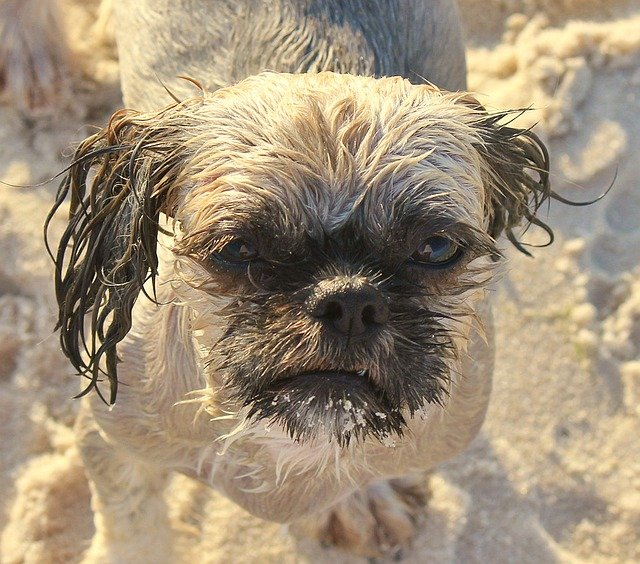Shih Tzus are not a fan of water, although, with the proper introduction, it is not unknown to see them paddling away.
This toy breed is far from a water lover, and you won’t find them dragging drowning victims to shore!
Shih Tzus In A Nutshell
Chinese tapestries from two thousand years ago first depict the Shih Tzu, although where this breed came from is still a bit of a mystery!
Shih Tzus were often gifted to Chinese emperors as temple gifts by Tibetan monks who treasured them.
The Shih Tzu’s name derives from “Shih-Tzu Kou,” which means “lion dog” – a word that aptly describes the facial features of this royal dog and that links the breed to Buddhist lore.
So prized was the little lion dog as a royal guardian that anyone caught with one risked execution.
The Shih Tzu is a guardian breed that long served as a companion for royals.
Since the focus was on appearance when developing this breed, the Shih Tzu is much less suited to physical activities like swimming.
The Shih Tzu Coat
The Shih Tzu’s long flowing coat also impedes their ability to swim.
The Shih Tzu’s coat should have a sturdy topcoat and a protective undercoat that does not mat.
However, over the years, this durable coat has remained dense but has become more prone to tangling and does not flow like it should (think of the Maltese skin).
Breeders continually struggle to regain the texture of the older Shih Tzu coat for a more desirable dog.
The long double coat combined with the small frame of the Shih Tzu can make it difficult for this small dog to swim through the water smoothly.
If you have ever seen this little pup swim, you will know that these pups turn into mops of hair when they hit the water!
The length and amount of hair aren’t the only problems for the Shih Tzu when it comes to water!
After one short swimming session, it can take days for the Shih Tzu coat to fully dry – imagine smelling like a wet dog for days! Not to mention how uncomfortable it must be!
Brachycephalic Breeds
Another obstacle for the Shih Tzus when it comes to swimming in the shape of their skull.
Shih Tzus are a brachycephalic breed. Brachycephalic translates to “short-headed, ” meaning that a dog has a flatter skull shape with a short muzzle.
Other brachycephalic breeds include English bulldogs, Pugs, Boston Terriers, and French Bulldogs.
Brachycephalic breeds have not always had such short muzzles; many brachycephalic dogs look drastically different today compared to how they were initially bred!
Brachycephalic breeds are dogs that were bred to hunt, and people once believed that creating a dog with a flatter muzzle increased their jaw strength and made them better at hunting.
Eventually, selective breeding led many of these dogs to have the severely malformed muzzles they have today.
Why Is Brachycephaly A Problem?
Brachycephalic dogs have a much shorter muzzle, and the face and skull structure make it harder for them to draw air into the lungs.
The compact airways of these breeds mean that less oxygen gets to the lungs, and this causes wheezing, snorting, difficulty breathing, and gurgling.
Additionally, a dog’s air conditioning system is its mouth – as they pant, saliva on the tongue evaporates and cools the body.
Dogs with a shorter muzzle and a more difficult time taking air are less efficient at cooling themselves when temperatures skyrocket in warmer months!
Swimming is anatomically complex for brachycephalic dogs – once they get in the water, they have to tilt their head back to breathe.
And, if a dog is swimming in hot weather, swimming becomes even more challenging as the dog’s air conditioner is less efficient at cooling down the body.
BAS( Brachycephalic Airway Syndrome)
Brachycephalic breeds have such a problem with their airways that Brachycephalic Airway Syndrome is a genuine veterinary problem.
Brachycephalic Respiratory Syndrome or BAS. BAS describes the many complications that occur in the respiratory patterns of brachycephalic breeds, including:
- Extended nasopharyngeal turbinates
- laryngeal collapse
- Everted laryngeal saccules
- Stenotic nares
- Elongated soft palate
- Hypoplastic trachea
Teaching Your Shih Tzus To Swim
While most Shih Tzus generally do not care for the water, it is still a good idea to teach your dog to swim for their safety.
Before teaching your Shih Tzu to swim, invest in a life jacket that fits snugly but not too tightly.
Not all dogs can instinctively swim, so it is better to always have a life jacket on your dog.
Also, invest in a pool ramp that will make it easy for your dog to get out of the pool if they are tired or accidentally fall into the water.
As you introduce your Shih Tzu to the water, do so gradually, and don’t force them to get in if they aren’t ready.
Let your pup investigate the water at their own pace.
If your dog does want to try swimming, stay in the water with them and guide them while keeping them in the shallow water.
Final Thoughts
The Shih Tzu does not have a natural draw to water like some breeds; in fact, most Shih Tzus will run the other way at the sight of a pool.
This doesn’t mean that it is impossible to get this little dog to swim, though; it just requires a gentle and gradual introduction to water early in life and a lot of positive reinforcement.

